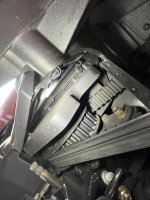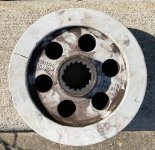The local 'in the know/in-house' guru guy here in Oz who will only speak on the basis of anonimity has told me that the White pulleys are essentially
EXACTLY the same construction as the 2014 & on earlier pulleys with the addition of the White ceramic coating - a ceramic coating that was added
purely to reduce the whistling noise the pulleys were making after the air flow around/thru the tupperware was changed with the model upgrade. :sour:
And according to him also, the 'Final Fix' pulley for the 'Red Dust Recall' pre-2020 Spyders identified by VIN as being part of that Recall is again essentially the same as the earlier 2014 & on pulleys
AND the White Ceramic Coated pulleys except for the addition of:
- a little extra machining (for the washer seat
 );
);
- the Washer itself;
- a slightly different bolt;
- a different coloured Ceramic Coating (Silver) to clearly differentiate them from all the others; AND
- the Locktite (appropriately cured!
 ) used to bond the Silver Pulleys onto the Engine Output Shaft!
) used to bond the Silver Pulleys onto the Engine Output Shaft!
:shocked:
So it appears that if you want the latest & greatest pulley for your Spyders, then:
- 2014 & on (if identified as being part of the Recall) thru to pre-2020, it's the Silver Recall version with the Washer & cured Locktite;
- post 2020 it's the White Ceramic Coated pulley without the Washer....
Only as many owners suspected would occur, there's a growing number of reports from owners having issues with the White Ceramic Coated pulleys failing along the same lines as the 'Red Dust Recall' pulleys that were failing thru fretting over time! :banghead:
All of which makes it fairly clear that the Locktite, appropriately cured before use, is a
MAJOR contributor to the 'Final Fix' for the 'Red Dust Recall' Pulleys!! And without that Locktite & appropriate curing time on
ANY 2014 & on front sprocket/pulley, you can expect it to fret and eventually fail to provide drive!

For whatever it's worth, Just Sayin' :gaah:
Unfortunately, your anonymous source appears to have supplied you incorrect information. As Mike, the blue knight 911 and many other owners of model year 2014 Spyder RT series have stated, the pulleys on our 2014 machines have not worn.
The pulley wear began with the 2015 models, so there is an apparent change of something from 2014 which had few issues to successive years that are plagued with problems.
If no change was made by BRP, the trends of no wear should have remained as they are for 2014 models.
Regarding the white pulley, if I recall correctly, these were deemed an interim pulley until the final fix pulley, mandated by the USA NHTSA recall has been completed.
The Silver pulley, machined to a narrower width at the spline engagements, accommodates a spacer to increase the surface area of contact pressure between the step of the gearbox output shaft and the face of the Silver pulley. This increased surface area lessens the likelihood of inadequate ability of the pulley face to prevent wear from the gearbox output shafts smaller diameter stepped area.
Regarding fretting, many years ago, I linked articles in regards to fretting corrosion as the main concern of the wear. The articles, clearly explained in layman's words, methods of fretting prevention.
Utilization of liquid shim products, such as Loctite products are one option. However, as I mentioned years ago, correct prep prior to use of the liquid shim is imperative, along with proper curing of the liquid shim. Additionally, while liquid shim is an excellent product when properly used, any premature breakdown of the shim will result in repeated failure.
The basis for my comments years ago, regarding fretting are fact based from years working as an aircraft structures technician, that has dealt with all forms of corrosion, including fretting corrosion for many decades, and a decade as an instructor for aircraft technicians for corrosion control and repair.
In regards to our own Spyder, and other owners I have discussed pulley longevity with, we have opted not to utilize the liquid shim method for adhesive bonding the pulley to the output shaft, but rather found a properly lubricated spline interface, reinspected at reasonable intervals, with lubricant replenished as we do on spline drives used in aircraft systems, to be a reasonable and long lasting alternative.
Kluberpaste was the BRP lubricant applied during assembly, and specified in maintenance manuals. Unfortunately, the Kluberpaste specs are inadequate for the intended task.
All the best to everyone contending with these issues. With luck BRP has resolved the issues for you.


